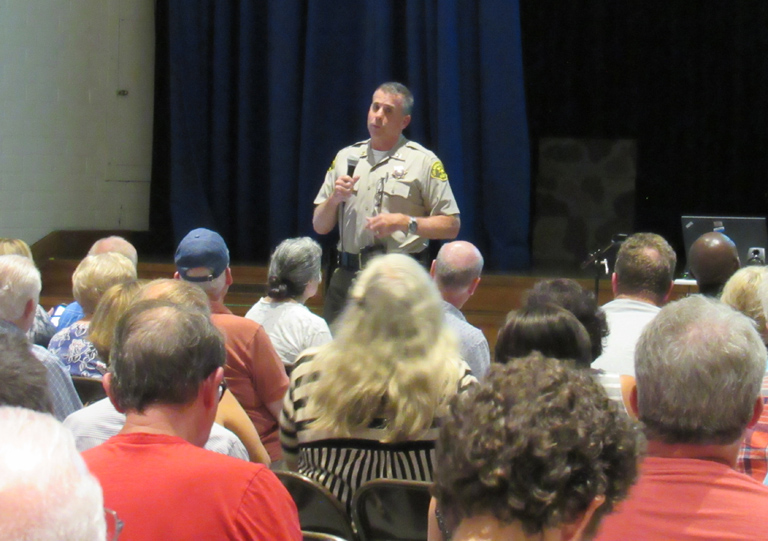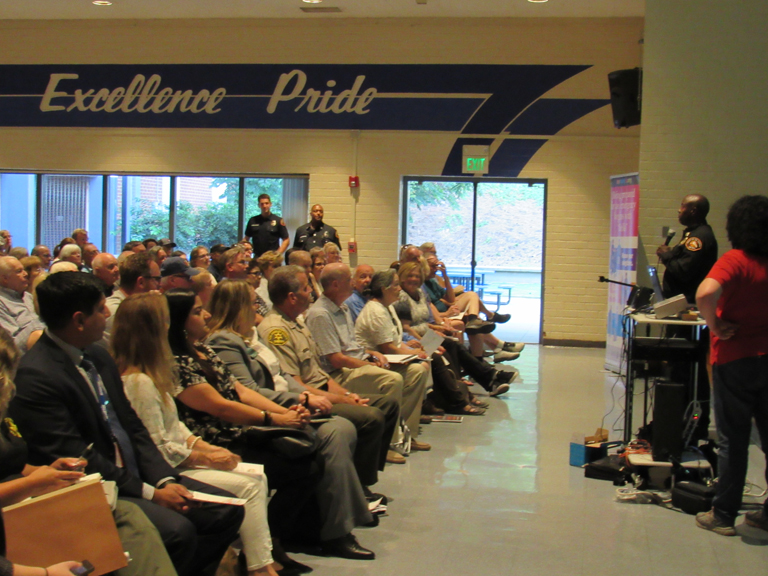
Every seat in the cafeteria of Rosemont Middle School was filled by attendees of the CV Fire Safe Council meeting on Monday night.
By Mary O’KEEFE
On Monday about 250 people attended the Crescenta Valley Fire Safe Council meeting that focused on Briggs Terrace. The event was held at the Rosemont Middle School cafeteria and representatives were in attendance from the office of Los Angeles County Supervisor Kathryn Barger and various Los Angeles County departments, LA County Fire Dept., U.S. Forest Service and Los Angeles Sheriff’s Dept.
Briggs Terrace is a unique group of neighborhoods within the unincorporated area of LA County/La Crescenta. It consists of 330 homes at the base of the Angeles National Forest and has extremely limited access in and out of the area, in addition to having narrow and winding streets. This limited access and tree-lined roads have concerned residents, whether living in Briggs Terrace or nearby, for a long time and the recent wildfires, specifically the Woolsey Fire, have heightened their concerns.
The CV Fire Safe Council was established just before the Station Fire in 2009. It is composed of community members from across the Crescenta Valley. Its purpose is to educate and advocate for proactive fire safe events like the one that focused on Briggs Terrace on Monday night.
CVFSC President Brian Hodge thanked Barger’s office for its support and for taking seriously the concerns of the residents.
Asst. Fire Chief Anderson Mackey spoke to the audience about the LACoFD Ready, Set, Go program that gives guidelines on how and when to evacuate during an emergency. He also spoke of the abatement inspections that have taken place and are taking place in the area. Depending on where a property is located, fire departments will come to a house to inspect brush clearance. This is to ensure that firefighters will have defensible space of 30 to 100 feet around houses in the case of a wildfire, depending on how close the house is to a wildland area.
Several residents in the audience told Mackey of neighbors who still had areas that needed to be cleared, and one couple shared that a neighbor had several items leaning up against the property that they were worried would help a fire spread. Mackey took their names and address and said he would send out inspectors. Bat. Chief Patrick Rohaley was on hand to take down addresses as well.
Capt. Todd Deeds from the CV Sheriff’s Station was also on-site to speak about evacuations. He said that deputies or other sheriff personnel will come through neighborhoods to alert residents of an evacuation. One resident said that she heard during an evacuation notice that residents were told to leave their home unlocked for easy access for law enforcement and fire. Both Deeds and Mackey said that would never be the case.
Mackey showed a video of two firefighters who made a rescue during the Woolsey Fire. The Woolsey Fire occurred on Nov. 8, 2018 and was the cause of three fatalities. It burned over 96,000 acres of land, destroyed 1,643 structures and had over 295,000 evacuations. In the film, the two firefighters shared their story of driving up a road to respond to a call from a woman who needed help. The smoke was so thick that at times there was zero visibility. They saw fire on either side of them as they continued to the woman’s home, which was difficult to find due to the smoke. The sky cleared for only a moment and they were able to see the address but soon the dark smoke covered the area again. One firefighter got out of the vehicle and went into the home to find the resident who was in need while the other firefighter slowly maneuvered the vehicle so they could quickly escape. Once the car was in position he went in to help his partner. The fire was all around them as they helped the woman into their vehicle and then they headed down the mountain road to safety. The video was an example of what firefighters go through to rescue those who, for one reason or another, did not evacuate in a timely manner or what happens if a fire burns too fast for people to evacuate.
Mackey again emphasized the importance of residents giving themselves enough time to evacuate and circled back to the information that can be found in Ready, Set, Go.
The meeting then took on a more interactive phase when the proposal of installing sirens was introduced. This is an issue that had been discussed within CVFSC for some time.
LACoFD spokeswoman Maria Grycan emphasized the sirens would not replace other forms of notification currently in place.
“I just want to make sure everybody understands what sirens mean to your community as a means of alerting people. There are other things that need to be considered. We just want you to know what this potentially could mean,” she said.
She added that sirens can only go to a maximum of 120 decibels, which would be very loud for the houses that were close to a siren. But due to its topography, Briggs Canyon would lose some of the effectiveness of the sirens as the noise transferred through trees and around the mountains.
“I want you to know that one siren is not going to cover Briggs Terrace,” Grycan said. “You are probably going to be looking at a minimum of three sirens to get maximum coverage.”
Sirens are also required to have monthly testing. Residents voiced concern about whether they would hear the sirens if they were in their homes with the windows closed, and were also worried about how their animals would respond to the noise.
Hodge said residents would be told in advance when the testing would occur. He also pointed out that many small communities throughout Northern California already have sirens.
Hodge rejected a suggestion that smoke and fire would be enough of a warning that a fire was nearby.
“Some people at the Camp Fire didn’t see the smoke. The fire was moving fast,” he said.
The Camp Fire occurred in Northern California, killing at least 85 people and destroying over 14,000 residences. It burned 153,000 acres in Butte County.
Hodge added the sirens are another tool that can be used to warn residents of a fire. It was announced at the meeting that Supervisor Barger would be introducing a motion requesting a pilot siren program be done in Briggs Terrace to study the effectiveness and environmental impact.
There was a concern about who would pay for the sirens, which can cost up to $800,000 each. Hodge gave examples of other cities and counties that paid through grants and donations for the sirens.
Barger’s motion will be made at a future supervisor meeting.
For more information on the CVFSC, visit cvfiresafecouncil.org. For Ready, Set, Go program information, visit www.fire.lacounty.gov/ready-set-go.


